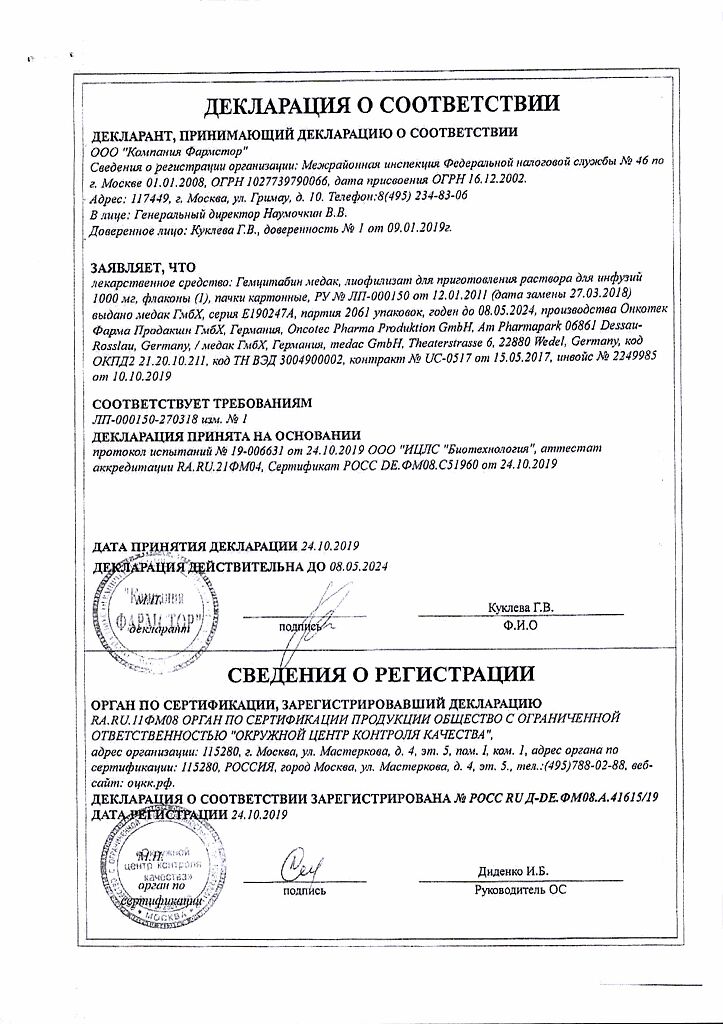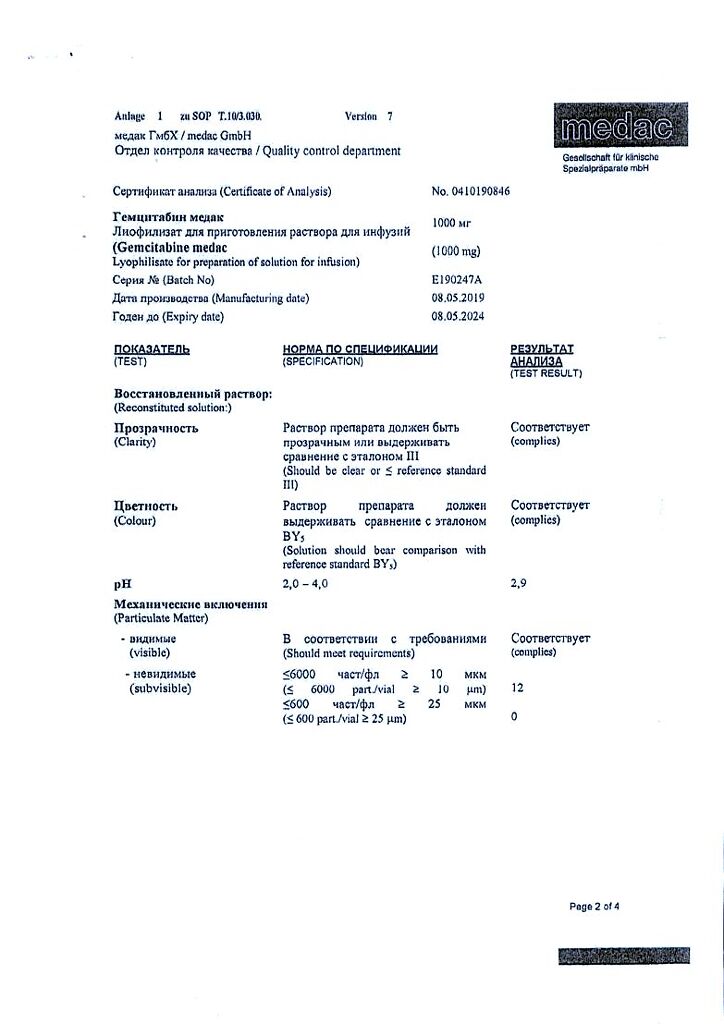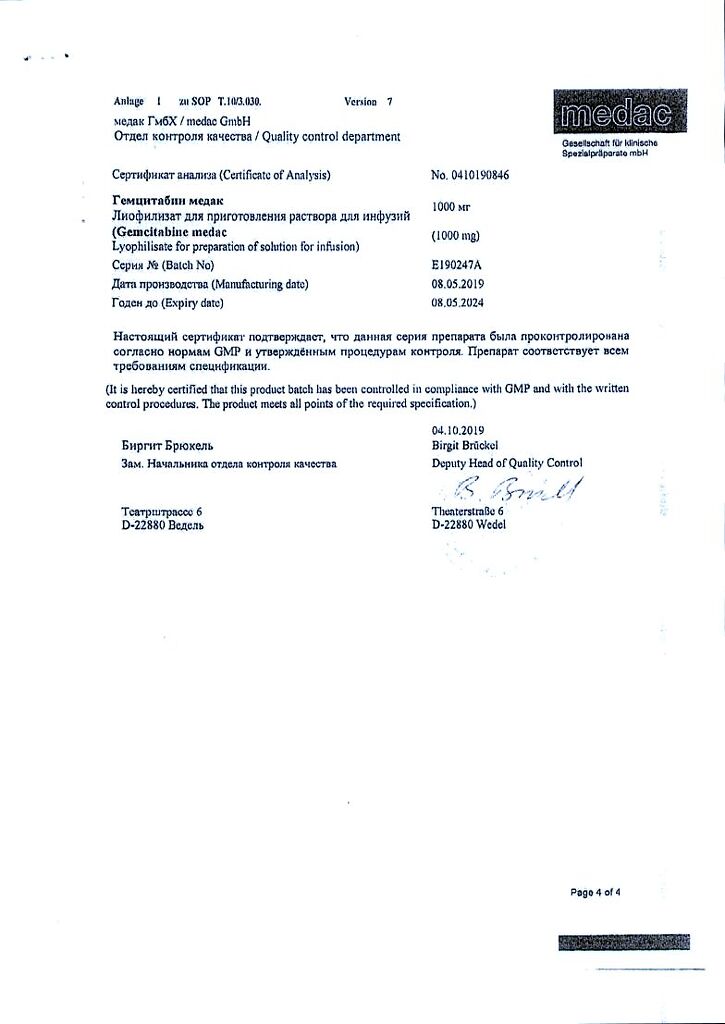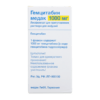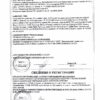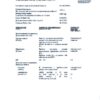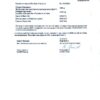No products in the cart.
Description
Antitumor agent, antimetabolite of pyrimidine analogues group, inhibits DNA synthesis. It exhibits cyclospecificity, acting on cells in S and Gl/S phases. It is metabolized in cells under the action of nucleosidkinases to active diphosphate and triphosphate nucleosides.
Diphosphate nucleosides inhibit the action of ribonucleotide reductase (the only enzyme that catalyzes the formation of deoxynucleoside triphosphates required for DNA synthesis). Triphosphate nucleosides are capable of being incorporated into the DNA strand (to a lesser extent RNA), which leads to the cessation of further DNA synthesis and programmed cell death (apoptosis).
Hemcitabine is also a strong radiosensitizing agent, even at concentrations lower than cytotoxic.
Pharmacokinetics
The Cmax of gemcitabine (3.2 µg/ml to 45.5 µg/ml) is reached 5 minutes after the end of infusions. Pharmacokinetic analysis of single- and multiple-dose administration studies shows that Vd is significantly gender dependent. Binding of gemcitabine to plasma proteins is insignificant.
In the body gemcitabine is rapidly metabolized by citidine deaminase in the liver, kidneys, blood and other tissues, resulting in the formation of gemcitabine mono-, di- and triphosphates (dFdCMP, dFdCDPand dFdCTP), of which dFdCDPand dFdCTP are considered active.
Hemcitabine is rapidly excreted with the urine mainly as the inactive metabolite 2′-deoxy-2′, 2′-difluoruridine. Less than 10% of the administered IV dose is detected in the urine in the form of unchanged gemcitabine. Systemic clearance, which ranges from approximately 30 L/h/m2 to 90 L/h/m2, is age- and sex-dependent: the excretion rate in women is approximately 25% lower than in men; in both men and women, the excretion rate decreases with age.
The T1/2 ranges from 42 min to 94 min. If the recommended dosing regimen is followed, complete excretion of gemcitabine occurs within 5-11 hours from the beginning of nnfusion. When administered once a week gemcitabine does not accumulate in the body.
Combination therapy with gemcitabine and paclitaxel. When co-administering gemcitabine and paclitaxel the pharmacokinetics of the drugs do not change.
Combination therapy with gemcitabine and carboplatin. The pharmacokinetics of gemcitabine and carboplatin are not altered when gemcitabine and carboplatin are coadministered.
Renal dysfunction. Renal insufficiency of mild to moderate degree (creatinine clearance 30-80 ml/min) has no significant effect on the pharmacokinetics of gemcitabine.
Indications
Indications
– locally advanced or metastatic non-small cell lung cancer as first-line therapy in combination with cisplatin, as well as in monotherapy in elderly patients with functional status equal to 2;
– Unresectable, locally recurrent, or metastatic breast cancer as part of combination therapy with paclitaxel after neoadjuvant and/or adjuvant therapy including anthracyclines, if there are no contraindications to their administration;
– locally advanced or metastatic urothelial cancer (cancer of the bladder, renal pelvis, ureters, urethra);
– locally advanced or metastatic epithelial ovarian cancer as monotherapy or in combination with carboplatin in patients with disease progression after first-line therapy with platinum-containing drugs;
– locally advanced or metastatic pancreatic cancer;
– locally advanced or metastatic cervical cancer.
Active ingredient
Active ingredient
Composition
Composition
1 vial:
gemcitabine hydrochloride 1138.5 mg, which corresponds to the content of gemcitabine 1000 mg
Auxiliary substances:
Mannitol,
Sodium acetate trihydrate,
Sodium hydroxide,
Hydrochloric acid.
How to take, the dosage
How to take, the dosage
Gemcitabine is given by IV drip for 30 minutes.
Non-small cell lung cancer
Monotherapy: Recommended dose is 1000 mg/m2 on days 1, 8 and 15 of each 28-day cycle.
Combination therapy with cisplatin: recommended dose of drug is 1250 mg/m2 on days 1 and 8 of each 21-day cycle or 1000 mg/m2 on days 1, 8 and 15 of each 28-day cycle Cisplatin is administered at a dose of 70-100 mg/m2 on day 1 of the cycle against a water load after gemcitabine infusion.
Combination therapy with carboplatin: The recommended dose of drug is 1000 mg/m2 or 1200 mg/m2 on days 1 and 8 of each 21-day cycle. Carboplatin is administered at an AUC of 5.0 mg/mL*min on day 1 of the cycle after gemcitabine infusion.
Breast cancer
Combination therapy: As 1st-line therapy for disease progression after neoadjuvant therapy including anthracyclines; the recommended dose of drug is 1250 mg/m2 on days 1 and 8 combined with paclitaxel at a dose of 175 mg/m2, which is administered on day 1 of each 21-day cycle by IV drip for approximately 3 h, before gemcitabine infusion.
Urothelial cancer
Monotherapy: the recommended dose of drug is 1250 mg/m2 on days 1, 8, and 15 of each 28-day cycle.
Combination therapy: the recommended dose of drug is 1000 mg/m2 on days 1, 8, and 15 in combination with cisplatin, which is administered at a dose of 70 mg/m2 immediately after gemcitabine infusion on day 1 or day 2 of each 28-day cycle.
Epithelial ovarian cancer
Monotherapy: the recommended dose of the drug is 800-1250 mg/m2 on days 1, 8, and 15 of each 28-day cycle.
Combination therapy: the recommended dose of drug is 1000 mg/m2 on days 1 and 8 in combination with carboplatin at an AUC4.0 mg/mL*min administered immediately after gemcitabine infusion on day 1 of each 21-day cycle.
Pancreatic cancer
Monotherapy:The recommended dose of drug is 1000 mg/m2 once weekly for 7 weeks, followed by a one-week break. Thereafter, the drug is administered on days 1, 8 and 15 of each 28-day cycle.
Cervical cancer (locally advanced or metastatic)
Combination therapy: In locally advanced cancer (neoadjuvant) and in metastatic cancer, gemcitabine is administered at a dose of 1250 mg/m2 on days 1 and 8 of each 21-day cycle. Cisplatin is administered at a dose of 70 mg/m2 after gemcitabine on day 1 of the cycle against a background of hyperhydration.
Adjust the drug dose due to hematologic toxicity phenomena
The initiation of the treatment cycle
Whatever the indication, platelet and granulocyte counts should be assessed before each administration of the drug.
The absolute neutrophil count of at least 1,500/µL and platelet count of at least 100,000/µL are prerequisites for treatment initiation.
Correction of the drug dose due to non-hematologic toxicity
In order to detect non-hematologic toxicity, periodic physical examination and monitoring of liver and kidney functions should be performed. The dose of the drug may be reduced in each subsequent cycle or during the cycle already started, depending on the degree of toxicity of the drugs prescribed to the patient. In case of severe (grade 3 or 4) non-hematologic toxicity, except in cases of nausea/vomiting, gemcitabine therapy should be suspended or the dosage should be reduced depending on the decision of the treating physician. The decision to resume treatment is up to the physician.
Method of administration
The infusion of gemcitabine is usually well tolerated by patients and can be given as an outpatient. If extravasation occurs, the infusion is stopped and the drug is resumed in another vein. After administration of gemcitabine, the patient should be monitored for some time.
Interaction
Interaction
There have been no specific studies of gemcitabine interactions.
Radiation therapy
Companion radiation therapy (concomitantly with gemcitabine or at < 7-day intervals prior to treatment): In this situation the toxicity of treatment depends on many factors, including the gemcitabine dose and frequency of administration, the radiation dose, radiation therapy method, the nature and volume of tissue being irradiated. Gemcitabine has been shown to have radiosensitizing activity.
. In one study where patients with non-small cell lung cancer received gemcitabine at a dose of 1000 mg/m2 for 6 consecutive weeks in combination with therapeutic irradiation to the chest area, significant toxicity was noted in the form of severe and potentially life-threatening mucosal inflammation, mainly esophagitis and pneumonitis, especially in patients with large tissue volume irradiation (median irradiated tissue volume 4795 cm3).
The combination of lower doses of gemcitabine and radiation therapy has been shown in subsequent studies to be better tolerated by patients and to have a predictable toxicity profile. For example, in one phase II study, patients with non-small cell lung cancer received radiation therapy at a dose of 60 Gy combined with gemcitabine (600 mg/m2 4 times) and cisplatin (80 mg/m2 2 times) for 6 weeks.
The sequential therapy (> 7 days break): Current data show that administration of gemcitabine more than 7 days before radiation therapy or more than 7 days after completion of radiation therapy is not associated with increased toxicity, except for skin lesions associated with the administration of chemotherapy after irradiation. Treatment with gemcitabine can be started 7 days after irradiation or after all acute radiation reactions have resolved.
With both concomitant and sequential use of gemcitabine and radiation therapy, radiation damage of irradiated tissues (e.g., esophagitis, colitis and pneumonitis) may occur.
The immunosuppressants (azathioprine, chlorambucil, glucocorticosteroids, cyclophosphamide, cyclosporine, mercaptopurine) increase the risk of infection.
Other interactions
The simultaneous use with live viral vaccines may intensify the replication process of the vaccine virus increase its side/adverse effects and/or decrease the production of antibodies in the patient’s body in response to the administration of the vaccine. Therefore, because of the risk of systemic, possibly fatal complications, especially in patients with compromised immune status, the interval between the use of gemcitabine and such vaccines should be at least 3 months or longer (up to 12 months), depending on the patient’s immune status.
There have been no studies of gemcitabine compatibility. Gemcitabine should not be mixed with other drugs.
Special Instructions
Special Instructions
Treatment with gemcitabine should only be done under the supervision of a physician experienced in the use of antitumor chemotherapy.
Before each administration of gemcitabine, the number of platelets, leukocytes and granulocytes in the blood should be monitored. If there are signs of depression of bone marrow function caused by the drug, treatment should be stopped or the dose adjusted.
The suppression of bone marrow function is usually short-term, does not require dose reduction, and rarely results in the need to interrupt treatment. Peripheral blood counts may continue to worsen after interruption of gemcitabine therapy.
When gemcitabine is used in combination with other anticancer chemotherapeutic agents, the risk of cumulative suppression of bone marrow function should be considered.
The patient should be evaluated regularly and renal and hepatic function should be assessed.
The administration of gemcitabine for liver metastases, a history of hepatitis and alcoholism, and cirrhosis increases the risk of liver failure. In case of signs of respiratory system adverse events (e.g., pulmonary edema, interstitial pneumonitis or respiratory distress syndrome in adults) during gemcitabine treatment, treatment should be discontinued and appropriate therapy should be prescribed.
In case of the first signs of microangiopathic hemolytic anemia, such as rapid decrease of hemoglobin with associated thrombocytopenia, increased serum bilirubin, creatinine, urea nitrogen or increased lactate dehydrogenase activity, gemcitabine should be withdrawn.
Lengthening the duration of infusion and the frequency of administration leads to increased toxicity.
The risk of skin reactions increases with a history of radiation therapy.
Depending on the degree of toxicity, the dose can be reduced during each cycle or in steps at the start of a new cycle.
Safe contraception should be used during treatment and for 6 months after gemcitabine therapy ends. Men receiving gemcitabine are advised to use sperm cryopreservation prior to treatment because of the risk of infertility associated with the use of this drug
When treating patients on a controlled sodium diet, the following amounts of sodium should be considered:
A bottle of 200 mg Gemcitabine medac contains 3.5 mg (< 1 mmol) of sodium,
A bottle of 1000 mg Gemcitabine medac contains 17.5 mg (< 1 mmol) of sodium,
a bottle of 1500 mg of Gemcitabine medac contains 26.3 mg (< 1 mmol) of sodium.
Influence on the ability to drive and operate machinery There are no data on the effect of gemcitabine therapy on the ability to drive and operate machinery, however, some side effects of the drug such as increased somnolence may adversely affect the ability to perform these activities. During gemcitabine treatment it is necessary to exercise caution while driving vehicles and engaging in potentially dangerous activities that require increased concentration and quick psychomotor reactions.
Contraindications
Contraindications
– hypersensitivity to the active substance or any of the excipients;
– pregnancy and lactation;
– children under 18 years of age (lack of sufficient data on the effectiveness and safety).
With caution: with impaired liver and/or kidney function, inhibition of bone marrow hematopoiesis (including against the background of concomitant radiation or chemotherapy), cardiovascular disease in the history, metastatic liver damage, hepatitis, alcoholism, with simultaneous radiation therapy, acute infections of viral, fungal or bacterial nature (including chickenpox, shingles).
Side effects
Side effects
Adverse reactions that occurred more frequently than in single cases are listed according to the following grading: very common (> 10%); common (> 1% to < 10%); infrequent (> 0.1% to < 1%); rare (> 0.01% to < 0.1%); very rare (< 0.01%).
Hematopoietic organs: often – leukopenia, neutropenia, thrombocytopenia, anemia; often – febrile neutropenia; very rarely – thrombocytosis.
Digestive system disorders: very often – nausea, vomiting, increased activity of “liver” transaminases (aspartate aminotransferase, alanine aminotransferase), alkaline phosphatase; often – anorexia, diarrhea, constipation, stomatitis, increased bilirubin concentration; rare – increase in gamma-glutamyltransferase activity; the frequency cannot be estimated on the basis of available data – ischemic colitis, toxic liver damage, including liver failure with lethal outcome.
Urinary system disorders: very common – mild hematuria and proteinuria; frequency cannot be estimated on the basis of available data – acute renal failure, clinical signs and symptoms similar to hemolytic-uremic syndrome (decreased hemoglobin, thrombocytopenia, increased bilirubin, creatinine, urea and/or lactate dehydrogenase in the serum).
Skin and skin appendages: very common – skin rash accompanied by itching, alopecia; frequent – skin itching, increased sweating; rare – ulceration, blistering, very rare – marked skin reactions, including desquamation and bullous rash; frequency cannot be estimated – Lyell syndrome, Stevens-Johnson syndrome.
Respiratory system: very common – shortness of breath; common – cough, rhinitis, infrequent – bronchospasm, interstitial pneumonia; frequency cannot be estimated – pulmonary edema, acute respiratory distress syndrome.
Cardiovascular system: rare – decreased blood pressure, myocardial infarction, the frequency cannot be assessed – arrhythmia (mainly supraventricular), heart failure, clinical signs of peripheral vasculitis and gangrene.
Nervous system disorders: frequent – headache, increased somnolence, insomnia; frequency cannot be estimated – stroke.
Others: very often – feeling of malaise, flu-like syndrome, peripheral edema; often – increased body temperature, chills, asthenia, back pain, myalgia; rarely – swelling of the face, reactions at the injection site; very rarely – anaphylactic reactions.
Overdose
Overdose
Symptoms:myelodepression, paresthesia, marked skin rash. No signs of overdose were observed when gemcitabine was administered in doses up to 5700 mg/m2 by IV drip 30 minutes every 2 weeks. The antidote for gemcitabine is unknown.
In case of suspected gemcitabine overdose, the degree of cytopenia should be monitored and symptomatic therapy should be administered if necessary.
Similarities
Similarities
Additional information
| Manufacturer | Onkotek Pharma Production GmbH, Germany |
|---|---|
| Medication form | lyophilizate |
| Brand | Onkotek Pharma Production GmbH |
Related products
Buy Gemcitabine medac, 1000 mg lyophilizate with delivery to USA, UK, Europe and over 120 other countries.


